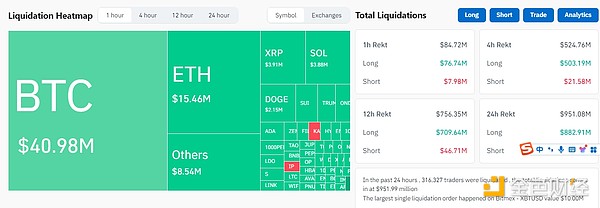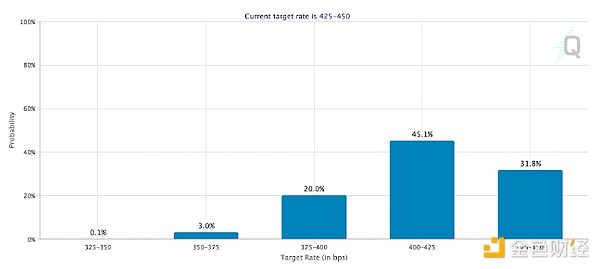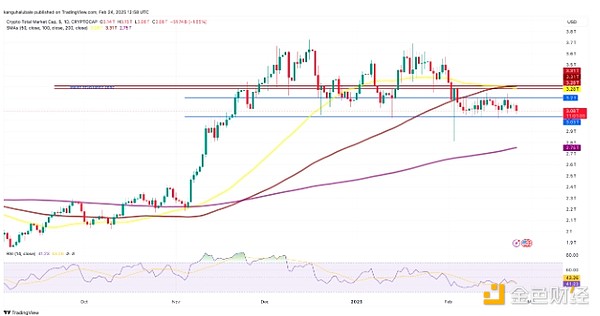What caused this crypto market to plummet? What do industry insiders say?

Reprinted from jinse
02/25/2025·2MCompiled by: Deng Tong, Golden Finance
Several specific factors have led to the latest decline in cryptocurrency prices, including:
-
The cryptocurrency market is still recovering from the $1.4 billion Bybit exchange hack.
-
With cryptocurrency investment products continuing to flow out, investors are in a safe-haven mode.
-
Strong upward resistance has curbed efforts to recover from global cryptocurrency market capitalization.
-
The U.S. stock market is difficult to get rid of the recent downturn.
Ethereum leads market crash
Today’s cryptocurrency market decline is part of a adjustment that began on February 21, when Bybit’s cryptocurrency exchange was hacked and lost more than $1.4 billion worth of ETH and ETH-related tokens, the largest ever Cryptocurrency theft case.
On February 25, the sell-off continued, including:
-
Ethereum led the market to decline, down 11.5% in the past 24 hours, trading at $2,503.26.
-
Bitcoin and Solana also fell, with Bitcoin down 4.9% to $91,549.81; Solana fell 15.7% to $141.76.
-
Other cryptocurrencies such as XRP fell 10.8%, Dogecoin fell 13.7%, and BNB fell 6.5%.
The problem is complicated by the massive liquidation of the derivatives market.

The sell-off triggered a leveraged position closing, and as of press time, a total of 316,393 traders were liquidated in the past 24 hours, with a total liquidation of US$952.08 million.
The dominance of long clearings suggests that the cryptocurrency market is over-leveraged on bullish terms.
Despite the current bearish market sentiment, cryptocurrency options trading platform QCP Capital said that cryptocurrency prices and implied volatility showed a mild reaction compared to the 2022 FTX crash.
QCP Capital said in a Telegram message that this “highlights the growing maturity of the cryptocurrency landscape”, adding:
“Bybit’s ability to quickly obtain bridge loans in critical times to fill the liquidity gap highlights the resilience and adequate liquidity in the lending sector. The industry has recovered steadily since 2022 and has experienced a significant slash before last year’s U.S. presidential election. Soaring."
Investors continue to evade cryptocurrency risks
The continued adjustment of the cryptocurrency market is consistent with the capital outflow of cryptocurrency investment products.
Key points:
-
The second consecutive week of capital outflows in digital asset investment products;
-
According to a report by CoinShares, the total outflow of funds was $508 million in the week ended February 21.
-
This shows that institutional investors have reduced their investment in digital assets.
-
Bitcoin has the largest outflow of funds, with a total amount of US$571 million.
-
Inflows so far this year fell from $7.4 billion two weeks ago to $6.6 billion last week.

Encrypt the capital flow of investment products. Source: CoinShares
James Butterfill, head of research at CoinShares , attributes this to uncertainty in trade tariffs, monetary policy and inflation. He said:
“We believe investors are keeping caution after the inauguration of the U.S. president and the uncertainty of trade tariffs, inflation and monetary policy that comes with it.”
Meanwhile, market participants are waiting for the last U.S. inflation data this week.
What to know:
-
The Personal Consumer Expenditure (PCE) index is the Fed's "first-choice" inflation indicator and will be released on February 28.
-
Last week, the number of first-time unemployment benefits applied for more than the median forecast of 4,000 to 219,000, indicating that labor market conditions are weakening.
-
This greatly lowers expectations for multiple rate cuts in 2025.
-
For example, according to the Chicago Mercantile Exchange Group's FedWatch tool, although two Fed meetings were scheduled during this period, the possibility of a rate cut is unlikely.

The target interest rate probability of the Federal Reserve's FOMC meeting on July 30. Source: CME
- The chances of the Federal Reserve keeping interest rates unchanged in the next two meetings are currently: 97.5% in March and 73% in May.
Cryptocurrency market faces huge overhead resistance
The market cap (total) decline in all cryptocurrencies today is part of the adjustment that began on January 31, with key support areas turning into resistance.
Key points:
-
TOTAL is trading below the key supply zone between $3.28 trillion and $3.31 trillion, i.e. the 50-day and 100-day simple moving average (SMA).
-
The Relative Strength Index (RSI) is currently at 40, indicating that market conditions are still favoring the downside.
-
Additionally, the sell-off could cause the cryptocurrency market to fall to the $3.03 trillion support level.
-
Please note that this has been a key support area for TOTAL since November 20.
-
A breakout above this level will trigger a sell-off, falling to a 200-day SMA of $2.72 trillion.

TOTAL/USD daily chart. Source: Cointelegraph/TradingView
Instead, pushing cryptocurrencies to market capitalization could bring it back to $3.2 trillion or higher to test the above resistance levels.
According to well-known analyst Crypto Zone, the "cryptocurrency market is in a neutral period" with a 40 index of fear and greed. ”
" This shows that investors are carefully weighing their actions and now is a critical moment in strategic decision-making," the analyst added.
U.S. stocks drag down crypto market
Following a sharp drop last week, major U.S. stock indexes failed to try to rebound Monday afternoon, with the Nasdaq closing down 1.2% and the S&P 500 falling 0.5%.
Quinn Thompson, founder of Lekker Capital, a crypto hedge fund that specializes in trading with macroeconomic data, posted on social media: “I try to convey this message to people who may feel complacent/denied: Compared to what I think we can do in 6 -$95,000 is still not a bad exit price for the price of trading within 12 months. "
Thompson believes that the probability of Bitcoin not hitting a new high in the next three months is 80%, and the probability of not hitting a new high in the next 12 months is 51%.
Speaking of the U.S. economy, Neil Dutta, head of economic research at Renaissance Macro Research, said the risks faced by the labor market are increasing. Real income growth slowed, real estate market deteriorated, and state and local governments were shrinking spending. Worryingly, the market generally believes that the economy will not slow down, with the median GDP forecast of around 2.5%.
“If 2023 is an unexpected rise, then 2025 is more likely to experience an unexpected decline,” Dutta wrote.
“ Passive tightening of monetary policy is the main risk , which has a significant impact on financial market investors,” Dutta continued. “I expect that as risk appetite weakens, long-term interest rates will fall and stock prices will fall. As far as the economy is concerned, job market conditions are expected to worsen.”
BTC bearish to $70,000
BitMEX co-founder Arthur Hayes said on social media that many IBIT holders are hedge funds, and they earn higher returns than short-term U.S. Treasury bonds by long ETFs and short CME futures. If the price of BTC decreases, the basis (i.e. the gap between ETF prices and futures prices) narrows, then these funds will sell IBIT and cover CME futures. These funds are currently profitable, and considering the basis is close to U.S. Treasury yields, they will close positions during the U.S. trading session to cash in on profits. I 'm bearish to $70,000.

Source: Coindesk, CoinTelegraph, Twitter


 panewslab
panewslab